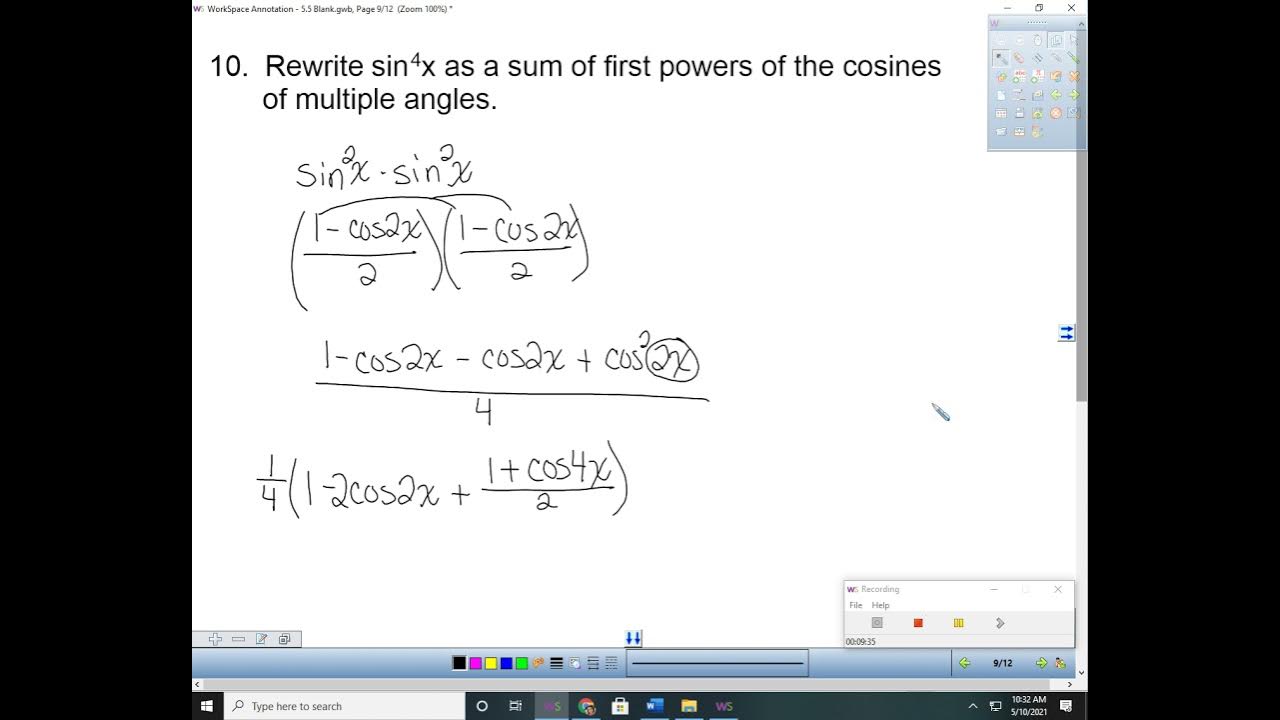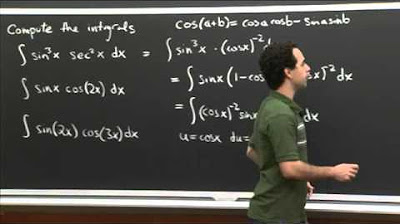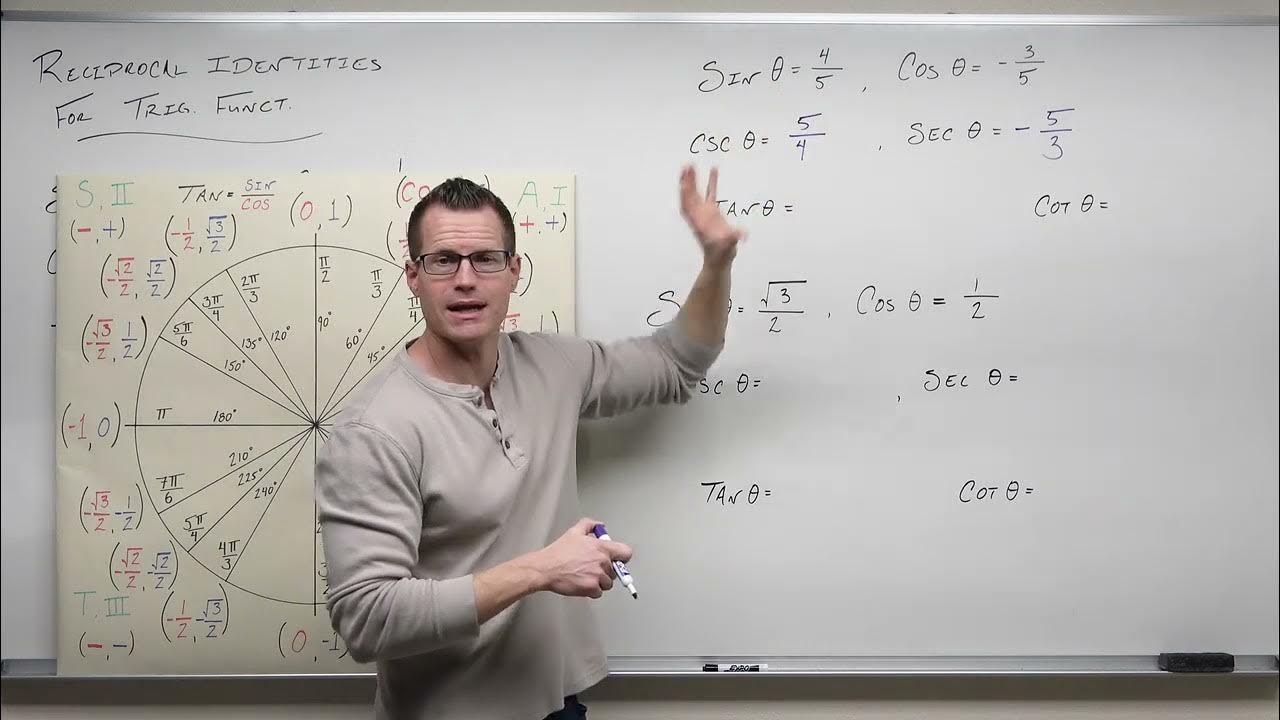5.4.2 Power-Reducing Identities
TLDRThis video explores power reducing identities, focusing on simplifying trigonometric functions with high powers. The host demonstrates how to rewrite cosine of the fourth power of X using these identities, ultimately transforming it into a form with only first-powered trig functions, making the concept accessible and engaging.
Takeaways
- 📚 The video discusses power reducing identities, aiming to simplify trigonometric expressions by reducing higher powers.
- 🔍 Power reducing identities are used to rewrite expressions with higher powers into forms without powers greater than one.
- 🌐 The identity for sine squared is given as (1 - cos(2u)/2).
- 🌐 The identity for cosine squared is (1 + cos(2u)/2).
- 🌐 The identity for tangent squared is (1 - cos(2u)/(1 + cos(2u))).
- 📉 The example in the video is to rewrite cos^4(x) using trig functions with no power greater than one.
- 🔄 The process begins by recognizing cos^4(x) as (cos^2(x))^2 and applying the power reducing formula for cos^2(x).
- 🔢 Squaring the fraction (1 + cos(2x)/2) involves squaring both the numerator and the denominator.
- 🧩 After squaring, the expression is simplified by combining like terms and using the distributive property.
- 🔄 Another power reducing identity is applied to the cosine squared term to further simplify the expression.
- 🔚 The final result is an expression with only first-powered trig functions, achieved by applying power reducing identities multiple times.
Q & A
What is the purpose of power reducing identities in trigonometry?
-The purpose of power reducing identities is to simplify expressions with higher powers of trigonometric functions into forms that do not have powers greater than 1.
What is the power reducing identity for sine squared of an angle U?
-The power reducing identity for sine squared of an angle U is 1 - cosine of 2U over 2.
What is the power reducing identity for cosine squared of an angle U?
-The power reducing identity for cosine squared of an angle U is 1 + cosine of 2U over 2.
What is the power reducing identity for tangent squared of an angle U?
-The power reducing identity for tangent squared of an angle U is 1 - cosine of 2U over 1 + cosine of 2U.
How can we rewrite the cosine of the fourth power of X using power reducing identities?
-We can rewrite the cosine of the fourth power of X by first expressing it as (cosine squared of X) squared, then applying the power reducing identity for cosine squared, and finally simplifying the resulting expression.
What happens when we square the fraction 1 + cosine of 2X in the power reducing identity?
-When we square the fraction 1 + cosine of 2X, we square both the numerator and the denominator, resulting in a new expression that includes terms like 1, cosine of 2X, and cosine squared of 2X.
How can we simplify the expression 1 + 2 cosine of 2X + cosine squared of 2X over 4?
-We can simplify this expression by splitting the fraction and applying the power reducing identity again to the cosine squared term, resulting in a sum of terms with trigonometric functions of different angles.
Why do we need to use the power reducing identity again after simplifying the expression to 1/4 + cosine of 2X/2 + cosine squared of 2X/4?
-We need to use the power reducing identity again because the expression still contains a term with a power greater than 1 (cosine squared of 2X), which we want to eliminate.
What is the final simplified form of the cosine of the fourth power of X after applying power reducing identities?
-The final simplified form is 3/8 + 4 cosine of 2X/8 + cosine of 4X/8, which is a sum of terms with first-powered trigonometric functions.
Why is it important to combine like terms and find common denominators when simplifying trigonometric expressions?
-Combining like terms and finding common denominators is important to simplify the expression to its most reduced form, making it easier to understand and work with in further calculations.
What is the significance of factoring out 1/8 in the final step of simplifying the cosine of the fourth power of X?
-Factoring out 1/8 in the final step allows us to consolidate the terms into a single fraction, which simplifies the overall expression and makes it neater.
Outlines
📚 Introduction to Power Reducing Identities
This paragraph introduces the concept of power reducing identities in trigonometry. The goal is to simplify expressions with higher powers, such as sine squared or cosine squared, into forms without powers greater than one. The identities for sine squared, cosine squared, and tangent squared are presented, which will be used to rewrite trigonometric functions. The example given is to simplify the cosine of the fourth power of X using these identities.
🔍 Simplifying Cosine to the Fourth Power
The paragraph details the process of simplifying the expression for cosine to the fourth power of X. It begins by recognizing that this is equivalent to squaring cosine squared of X. The power reducing identity for cosine squared is applied, resulting in an expression that still contains a squared term. The process involves squaring the fraction, expanding the terms, and combining like terms. The fraction is then split and simplified further by applying another power reducing identity to the cosine squared term, ultimately resulting in an expression with only first-powered trigonometric functions.
🎉 Conclusion of the Power Reduction Process
The final paragraph concludes the video script by summarizing the successful reduction of the cosine to the fourth power of X using power reducing formulas. The process involved multiple applications of these identities and careful manipulation of trigonometric expressions to achieve a simplified form. The video ends with a thank you to the viewers for watching.
Mindmap
Keywords
💡Power Reducing Identities
💡Sine Squared Identity
💡Cosine Squared Identity
💡Tangent Squared Identity
💡Cosine of the Fourth Power
💡Squaring a Fraction
💡Foil Method
💡Combining Like Terms
💡Common Denominators
💡Factoring Out
💡First Powered Trigonometric Functions
Highlights
Introduction to power reducing identities and their purpose.
Explanation of sine squared identity: 1 - cos(2u)/2.
Cosine squared identity: 1 + cos(2u)/2.
Tangent squared identity: 1 - cos(2u) / (1 + cos(2u)).
Objective to rewrite cos^4(x) using trig functions with no power greater than 1.
Recognizing cos^4(x) as (cos^2(x))^2 and applying power reducing formulas.
Squaring the fraction 1 + cos(2x)/2 and expanding the terms.
Combining like terms to simplify the expression.
Splitting the fraction into two parts for further simplification.
Reduction of the fraction 2/4 to 1/2.
Using another power reducing identity to simplify cos^2(2x).
Distributing the fraction and simplifying the terms inside the parentheses.
Combining like terms and finding common denominators.
Final simplification by factoring out 1/8 and combining terms.
Achieving the goal of expressing cos^4(x) with first-powered trig functions only.
Conclusion and thanks for watching.
Transcripts
Browse More Related Video

5.5 Multiple Angle and Product to Sum Formulas (Part 2)

Ex 2: Simplify Trigonometric Expressions

5.2.3 Identities in Calculus

Trig Integral Practice | MIT 18.01SC Single Variable Calculus, Fall 2010

Reciprocal Identities in Trigonometry (Precalculus - Trigonometry 9)

Simplifying Trigonometric Expressions Using Power Reducing Formulas
5.0 / 5 (0 votes)
Thanks for rating: